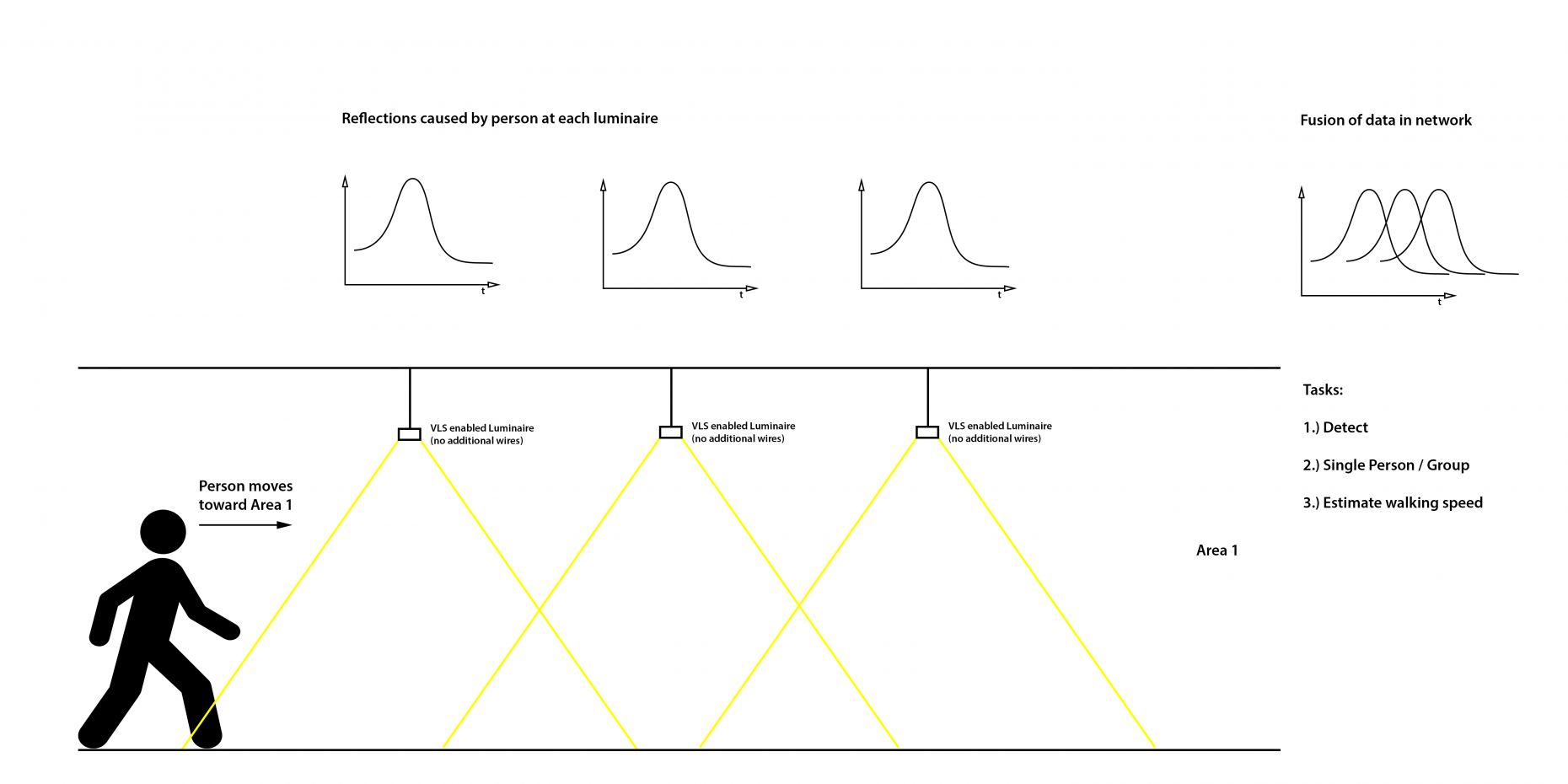Vilipa - Visible light based Person and Group Detection in existing buildings
Short Description
Motivation and research question
One of the key elements to combat the energy and climate crisis is to make the operation of buildings more energy efficient. Worldwide, buildings are responsible for up to 40% of total energy consumption. Therefore, many efforts are being made to reduce the energy consumption of buildings. In order to achieve this without compromising the comfort of the people in the building, technological innovations in various areas are necessary. Reliable occupancy information is an essential aspect for the demand-driven, thus energy-efficient operation of a building's heating, ventilation and air conditioning system. For the realization of such systems, different technologies and methods are currently used, which, however, in many cases result in extensive installation efforts. Additionally some of the technologies used, trigger data protection concerns. Especially in the area of existing buildings, the expected installation effort prevents the use of occupancy detection systems due to economic concerns, although the potential of such systems to reduce energy demand is beyond question.
Based on the need to realize occupancy information systems using existing infrastructure, this exploratory project focused on extending the functions of the lighting infrastructure. The approach pursued for the recognition of persons on the basis of the reflection of visible light caused by the person himself, known under the synonym Visible Light Sensing, and the derived occupancy detection in areas of buildings represents such an innovative approach. The main research questions to be addressed for the realization of such a system were:
- Technical feasibility of an occupancy detection system based on Visible Light Sensing
- Reliable detection in different light conditions and environments
- Possibilities for communication without additional installation effort
- Possibilities for seamless integration or retrofit approaches
Project contents and objectives
The project objective was to verify the economic and technical feasibility of an approach to generate occupancy information by means of photosensitive elements integrated into the lighting fixture, based on the technology of Visible Light Sensing. One of the main focuses was on robust, reliable detection of people, their direction of movement and walking speed under varying lighting conditions and environmental conditions. In particular, the large expected variation of the reflections or intensities of the reflected light, based on different body sizes, hairstyles and clothing, posed a challenge, especially in the area of algorithm development. In order to make the planned system economically feasible for the usage in existing buildings, another focus of the project was to enable communication between the lighting fixtures without the need for additional installation work. The overall goal of the exploratory work was to demonstrate the potential for expanding the functions of the lighting infrastructure and thus to further advance the evolution of lighting from a mere light source to an active player in the building.
Methodical procedure
The methodological approach, followed an iterative development concept. Extensive measurements were carried out at the component and subsystem level at a very early stage of the project in order to identify problems as early as possible and to be able to take appropriate countermeasures. This included not only the characterization of the effects of changing light conditions on the Visible Light Sensing approach, but also changing environmental influences, such as different floor materials. These early measurement results and the knowledge gained from them, also formed the basis for the concept development and realization of the laboratory samples created, both in terms of the components used and in the area of algorithm development. The concept development as well as the final realization of the Powerline communication of the laboratory samples also followed this iterative approach, starting with the extensive survey of the available relevant components, followed by the characterization of single components or subsystems, and finally the integration into the laboratory samples. Finally, the manufactured laboratory samples were tested, optimized and evaluated in extensive measurement trials in different testbed environments as close to reality as possible with regard to the achievable results.
Results and conclusions
During the extensive measurement tests in different testbed environments, the reliable and robust implementation of occupancy detection using Visible Light Sensing was demonstrated. In particular, the achieved independence from environmental influences (e.g.: sunlight) and the large variation of the parameters of the persons (size, hair, clothing) represents a significant added value, especially with regard to further activities.
An important aspect was the integration of the photosensitive elements into an existing off-the-shelf luminaire with standard dimensions, which underlines the resulting advantage of easy installation and the possibility of a retrofit solution. Furthermore, with the realized Powerline communication, the intended interface was successfully implemented, which in turn underlines the approach of enabling a low complex solution.
Especially the compact design and the implemented algorithm approach proved the future-oriented innovative approach and demonstrated the feasibility in technical as well as economic terms.
Outlook
The successful demonstration of Visible Light Sensing based occupancy detection, integrated into the lighting infrastructure, is the basis for further developments or transformation of this approach into area-wide applications. Especially the low installation effort, as well as the preservation of the privacy of the persons represent a significant advantage compared to other technologies and methods in this field.
Project Partners
Project management
- Dr. Andreas Peter Weiss
- Joanneum Research Forschungsgesellschaft.mbH
Project or cooperation partners
Graz University of Technology (TUG) - Institute of Microwave and Photonic Engineering (IHF)
Contact Address
JOANNEUM RESEARCH Forschungsgesellschaft mbH
MATERIALS - Institut für Oberflächentechnologien und Photonik Smart Connected Lighting
Dr. Andreas Peter Weiss
Industriestraße 6
A-7423 Pinkafeld
Tel.: +43 (316) 876-3605
E-mail: andreas-peter.weiss@joanneum.at
Web: www.joanneum.at/materials/das-institut/forschungsgruppen/smart-connected-lighting

